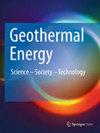The Upper Jurassic carbonates are the prime target for deep geothermal exploration in the Molasse basin, South Germany. The carbonates have a thickness of over 500m (1640 ft) and consist of two major facies: (1) bedded marly limestone and (2) massive limestone and dolostone. The massive limestone facies is composed of sponge-microbial biohermal buildups It is considered the main geothermal reservoir facies. Only this facies type may be (1) karstified, (2) dolomitized, and/or (3) faulted and fractured, and therefore can yield very high flow rates of >100 l/sec = 26 gps. The main data source used in this study is the 3D seismic survey of the Freiham geothermal field in the western part of Munich/Germany. Blended in were cutting logs to describe the lithology from 2 wells and borehole image logs from the two geothermal wells. Lithologies derived from these wells were upscaled in support of the seismic interpretation. The study presents an integrated workflow of 3D seismic attribute analysis to analyze the distribution and quantification of reservoir facies (massive limestone) versus non-reservoir facies (bedded marly limestone) per time slice. The attribute “sum of magnitude” is mapped for 9-time slices based on the vertical resolution of the Freiham 3D cube. The seismic facies interpretation is compared with upscaled borehole image facies associations of two geothermal wells. BHI log data is calibrated with an interpretation of the depositional environment based on cutting analysis Reservoir geometries were derived from an outcrop analog study to better understand the 3D seismic facies interpretation and to construct the conceptual depositional model of the Upper Jurassic carbonates. This technique is commonly used in hydrocarbon exploration but is not yet adapted to geothermal projects, which are often based on little data, smaller company sizes, tight budgets, and limited access to specialized geomodelling software and experience. The approach of using 3D seismic attribute analysis presented in this study provides a quantitative subsurface model of geothermal reservoir facies in the Freiham geothermal field. It is quick and straightforward and can easily be applied in the exploration workflow for similar fields and reservoirs.


